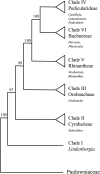Primers for Castilleja and their utility across Orobanchaceae: II. Single-copy nuclear loci
- PMID: 28989822
- PMCID: PMC5628026
- DOI: 10.3732/apps.1700038
Primers for Castilleja and their utility across Orobanchaceae: II. Single-copy nuclear loci
Abstract
Premise of the study: We developed primers targeting nuclear loci in Castilleja with the goal of reconstructing the evolutionary history of this challenging clade. These primers were tested across other major clades in Orobanchaceae to assess their broader utility.
Methods and results: We assembled low-coverage genomes for three taxa in Castilleja and developed primer combinations for the single-copy conserved ortholog set (COSII) and the pentatricopeptide repeat (PPR) gene family. These primer combinations were designed to take advantage of the Fluidigm microfluidic PCR platform and are well suited for high-throughput sequencing applications. Eighty-seven primers were designed for Castilleja, and 27 were found to have broader utility in Orobanchaceae.
Conclusions: These results demonstrate the utility of these primers, not only across Castilleja, but for other lineages within Orobanchaceae as well. This expanded molecular toolkit will be an asset to future phylogenetic studies in Castilleja and throughout Orobanchaceae.
Keywords: Castilleja; Orobanchaceae; high-throughput sequencing; microfluidic PCR; single-copy nuclear genes.
Figures
Similar articles
-
Phylogenetic Relationships in Orobanchaceae Inferred From Low-Copy Nuclear Genes: Consolidation of Major Clades and Identification of a Novel Position of the Non-photosynthetic Orobanche Clade Sister to All Other Parasitic Orobanchaceae.Front Plant Sci. 2019 Jul 16;10:902. doi: 10.3389/fpls.2019.00902. eCollection 2019. Front Plant Sci. 2019. PMID: 31379896 Free PMC article.
-
Primers for Castilleja and their utility across Orobanchaceae: I. Chloroplast primers.Appl Plant Sci. 2017 Sep 29;5(9):apps.1700020. doi: 10.3732/apps.1700020. eCollection 2017 Sep. Appl Plant Sci. 2017. PMID: 28989821 Free PMC article.
-
Characterization of microsatellite loci in Castilleja sessiliflora and transferability to 24 Castilleja species (Orobanchaceae).Appl Plant Sci. 2013 May 16;1(6):apps.1200564. doi: 10.3732/apps.1200564. eCollection 2013 Jun. Appl Plant Sci. 2013. PMID: 25202558 Free PMC article.
-
From annuals to perennials: phylogeny of subtribe Castillejinae (Orobanchaceae).Am J Bot. 2008 May;95(5):608-25. doi: 10.3732/ajb.2007346. Am J Bot. 2008. PMID: 21632387
-
Utility of low-copy nuclear gene sequences in plant phylogenetics.Crit Rev Biochem Mol Biol. 2002;37(3):121-47. doi: 10.1080/10409230290771474. Crit Rev Biochem Mol Biol. 2002. PMID: 12139440 Review.
Cited by
-
Phylogenetic Relationships in Orobanchaceae Inferred From Low-Copy Nuclear Genes: Consolidation of Major Clades and Identification of a Novel Position of the Non-photosynthetic Orobanche Clade Sister to All Other Parasitic Orobanchaceae.Front Plant Sci. 2019 Jul 16;10:902. doi: 10.3389/fpls.2019.00902. eCollection 2019. Front Plant Sci. 2019. PMID: 31379896 Free PMC article.
References
-
- Altschul S. F., Gish W., Miller W., Meyer E. W., Lipman D. J. 1990. Basic local alignment search tool. Journal of Molecular Biology 215: 403–410. - PubMed
-
- Bennett J. R., Mathews S. 2006. Phylogeny of the parasitic plant family Orobanchaceae inferred from phytochrome A. American Journal of Botany 93: 1039–1051. - PubMed
Associated data
LinkOut - more resources
Full Text Sources
Other Literature Sources
Research Materials


